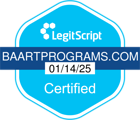Codeine is an opiate used to treat acute or moderate pain. Because codeine disrupts the brain’s pain-relieving functionality, users can quickly develop dependence and addiction. When a person becomes addicted to codeine, the substance is used to achieve a high.
If you or a loved one has developed an addiction to codeine, it’s important to get help immediately. Talk to a trained advisor on our BAART Program helpline at 844-341-4040 to find a treatment center near you.
What Are Codeine Addiction Symptoms?
A person may experience euphoria, elation, or drowsiness after taking codeine. When addiction occurs, they will feel they need to take the drug before they can function normally. If you think that you or someone you know may be addicted, here are some of the symptoms to look for:
- Loss of appetite
- Weight loss
- Poor physical coordination
- Reduced attention span
- Mood swings that happen without reason
- Altered sleeping patterns
- Sweaty hands
When addiction has become severe, these symptoms may appear:
- Hallucinations
- Fluctuation in blood pressure
- Reduced heart rate
- Reduced sex drive
- Kidney problems
- Liver damage
- Difficulty breathing
What Are the Types of Codeine Addiction Treatment?
Codeine addiction is treatable. Effective codeine addiction treatment combines medical care, cognitive therapies, counseling and aftercare programs that help the patient achieve sobriety and avoid relapse. Treatments for codeine addiction can include:
- Behavioral therapy
- Counseling
- Inpatient and outpatient (hospital-based) treatment
- Medication-assisted treatment (MAT)
Over the years, medication has been one of the most effective ways to treat codeine addiction. The medications used for treating codeine misuse or addiction include methadone, naltrexone and buprenorphine. Buprenorphine and methadone can reduce cravings for codeine and withdrawal symptoms. Both medications act on the same parts of the brain as other opioids, but they don’t provide the same euphoria when taken as prescribed at a therapeutic dose.
Contrary to what some people believe, taking these medicines is not substituting one addiction for another. Medication-assisted treatment helps restore balance to areas of the brain affected by addiction to codeine or other opioids. This balance enables the brain to heal while the patient works toward full recovery.
Naltrexone has a different effect on the brain than methadone. It takes away the high or euphoria that comes from taking opioids, but it doesn’t take away cravings or withdrawal symptoms.
What Is Medication-Assisted Therapy?
Medication-assisted therapy combines the use of medicines, various types of counseling and behavioral therapy. This combination is a holistic approach that addresses the needs of the whole patient, and it offers a higher chance of a full recovery.
Counseling can help patients recovering from codeine addiction:
- Develop new attitudes and behaviors that lead to sobriety
- Build new healthy lifestyle skills
- Remain committed to taking medication
Counselors may also provide information about other resources that can improve the outcome of the patient’s treatment.
Learn More About Codeine Addiction Recovery
To discover more about how you or your loved one can benefit from BAART Programs in your area, reach out to us today. You can also read more articles about how we treat opioid addiction at BAART.



